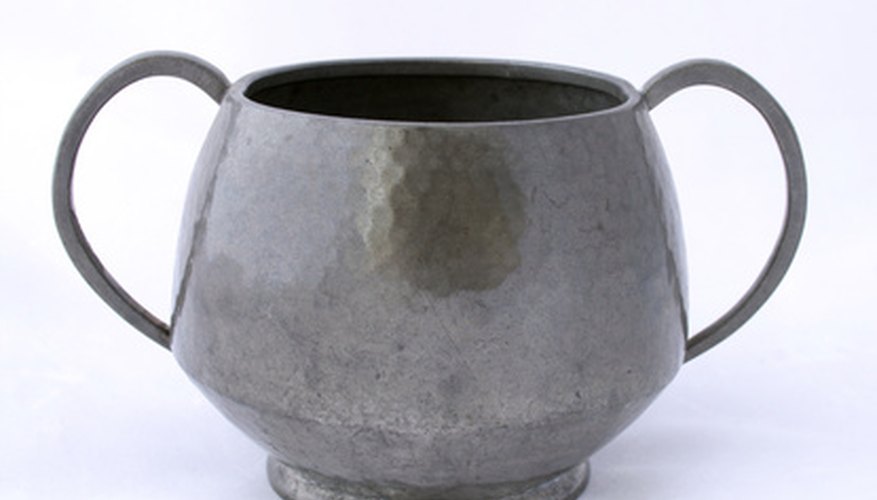Historically, pewter tankards and utensils were considered the poor man's silver. Solid sterling silver was a sign of wealth and prosperity and only the well-to-do could afford it. Electroplating pewter provided the look of silver without the cost.The multi-step process required that the piece first be plated with alkaline copper before proceeding to plate it with silver. This process transformed a dull matt pewter piece into an article that looked like sterling and could be polished to a bright shine. You can try electroplating pewter yourself using a few simple materials.
Pewter to copper plate
Clean the surface of your pewter using soap and water. Rinse thoroughly.
Polish the surface of your pewter with pumice powder and extra fine steel wool to roughen the surface.
Prepare a solution of potash and water in the one-quart can using 113 g (4 oz) of potash dissolved in 711 ml (3 cups) of water.
Mix thoroughly.
Dip your pewter in the potash solution using a stainless steel hook.
Place the steel suspension rod across the perimeter of the 1 litre (1 quart) can. Suspend your dipped pewter piece from the rod so the piece hangs into the can while drying.
Measure and mix 113 g (4 oz) of copper sulphate in 340 g (12 oz) of water in one of the gallon cans. Add a strong solution of water and ammonia until green crystals appear.
Add liquid ammonia at full strength until no more green crystals appear and the existing ones dissolve into a bright blue solution.
Add a strong solution of potassium cyanide until the blue colour disappears. Add 1/4 as much potassium cyanide as you used above.
Add water until you have 2 litre (2 quarts) of liquid in the paint can.
Move the suspending rod with the pewter hanging from it until the rod rests across the diameter of the paint can and the pewter is covered by the liquid in the can.
Connect one positive and one negative lead to the corresponding terminals of your 4 volt battery. Connect the other positive lead to the edge of the paint can and the negative lead to the hook holding the pewter piece. A charge of 3.5 to 4 volts will remove the copper from the solution and attract it to coat the surface of the pewter.
- Clean the surface of your pewter using soap and water.
- A charge of 3.5 to 4 volts will remove the copper from the solution and attract it to coat the surface of the pewter.
Copper plate to silver plate
Dissolve 21 g (3/4 oz) of silver nitrate with 227 g (8 oz) of water in the remaining 4.5 litres (1 gallon) can. Add potassium cyanide to the solution. White crystals will appear.
Add more potassium cyanide until all of the crystals are dissolved and no more appear. Add 1 litre (1 quart) of water to the liquid in the paint can.
- Dissolve 21 g (3/4 oz) of silver nitrate with 227 g (8 oz) of water in the remaining 4.5 litres (1 gallon) can.
- Add 1 litre (1 quart) of water to the liquid in the paint can.
Move your copper plated pewter so that it is covered by the solution in the second paint can and hangs suspended as in Part 1, Step 10 above.
Connect the battery to the copper plated piece as you did in Part 1, Step 11 above. Two to four volts of electricity running through the second solution will cover the copper plate with silver plate. Remove the plated piece and allow it to dry.
Polish the plated silver with quick, light strokes using extra fine steel wool. Add silver plate polish according to package directions. Buff the plated silver with your polishing cloth to produce a bright shine.
TIP
All chemicals and equipment are available at your local hardware shop.
WARNING
Wear a protective mask, glasses and gloves when handling chemicals. Mix chemicals in a protected, well-ventilated area. Keep all chemicals out of the reach of children.
